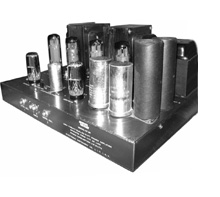 |
EICO HF-89 stereo power amplifier |
|
AT A GLANCE: The EICO HF-89 is a dual 50-watt power amplifier, in which the tubes and components are operated conservatively and which meets its published specifications in all important respects. It is constructed on a large chassis, with good ventilation for tubes and other components. The HF-89, available in kit form or factory-wired, is an excellent choice for the person who wants the advantages of a high- powered, clean amplifier at a relatively modest price. As a kit, it sells for $99.50 (factory-wired, $139.50). IN DETAIL: The EICO HF-89, for such a powerful amplifier, has a remarkably small tube complement. Only seven tubes are used, with a pair of EL-34s in each output stage. The output tubes are operated well within their dissipation ratings (a point on which some otherwise excellent amplifiers fall down), and the filter capacitors are also safely operated. A silicon rectifier voltage doubler power supply is used. This results in reduced power transformer size and weight, cooler over-all operation, and better regulation. The latter point is important, especially on a high-powered amplifier where an appreciable difference between quiescent tube currents and the currents drawn at full power output may exist. In a poorly regulated power supply, a voltage drop under strong signal conditions limits the maximum power output obtainable under steady-state conditions. EICO emphasize in their instruction manual that the HF-89 delivers full rated power from both channels simultaneously, due to their good power supply regulation.
The excellent low frequency performance of the HF-89 is evident in the close correspondence between the 20-cps harmonic distortion curve and the intermodulation distortion curve. In both cases, the distortion at usual listening levels under 10 watts is a small fraction of one per cent, and the IM distortion does not reach 2% until output of 70 watts per channel is reached. There is no point in plotting frequency response, for it would be virtually a straight line. It was within 0.1 db up to 10 kc, and down 0.4 db at 20 kc. This is within the possible range of our instrument errors. The EL-34 output tubes were operated well below their maximum dissipation ratings, and filter capacitors never were subjected to more than about 90% of rated voltage. This, combined with the large, open construction of the HF-89, suggests the likelihood of long life without component failure. The stability of the amplifier was good under capacitive loads, and it rates above average in ability to drive large capacitive loads at high frequencies. The hum level was very low when the input was shorted or driven from a low impedance source (such as the output of most preamplifiers). It was typically about 88 db below 10 watts output. With a higher driving impedance it was about 70 db below 10 watts. Even this is quite inaudible in practice. The HF-89 had the effortless, solid sound typical of a good, high-powered amplifier at a relatively modest price. H. H. LABS. |
|||
 Taken
from 'High Fidelity' magazine, March 1961
Taken
from 'High Fidelity' magazine, March 1961 Our
measurements verified EICO's claims quite closely. The power response
of the HF-89 was very flat, with full 50 watts per channel available
from 30 cps to 20 kc at 1% distortion. Even at 20 cps it delivered
35 watts per channel at 1% distortion. The power bandwidth, in accordance
with IHFM standards on amplifier measurements, is in excess of 20
to 20,000 cps referred to 50 watts at 1% distortion. These measurements
were made with both channels driven to the same output simultaneously.
Our
measurements verified EICO's claims quite closely. The power response
of the HF-89 was very flat, with full 50 watts per channel available
from 30 cps to 20 kc at 1% distortion. Even at 20 cps it delivered
35 watts per channel at 1% distortion. The power bandwidth, in accordance
with IHFM standards on amplifier measurements, is in excess of 20
to 20,000 cps referred to 50 watts at 1% distortion. These measurements
were made with both channels driven to the same output simultaneously.